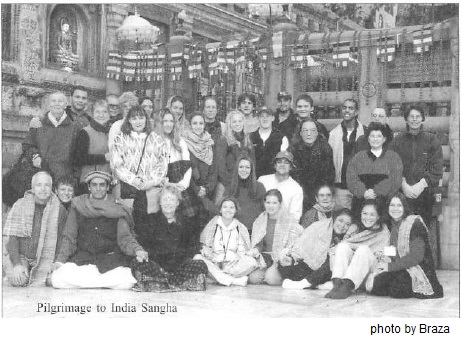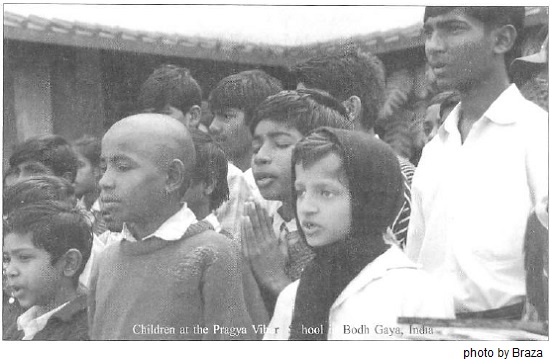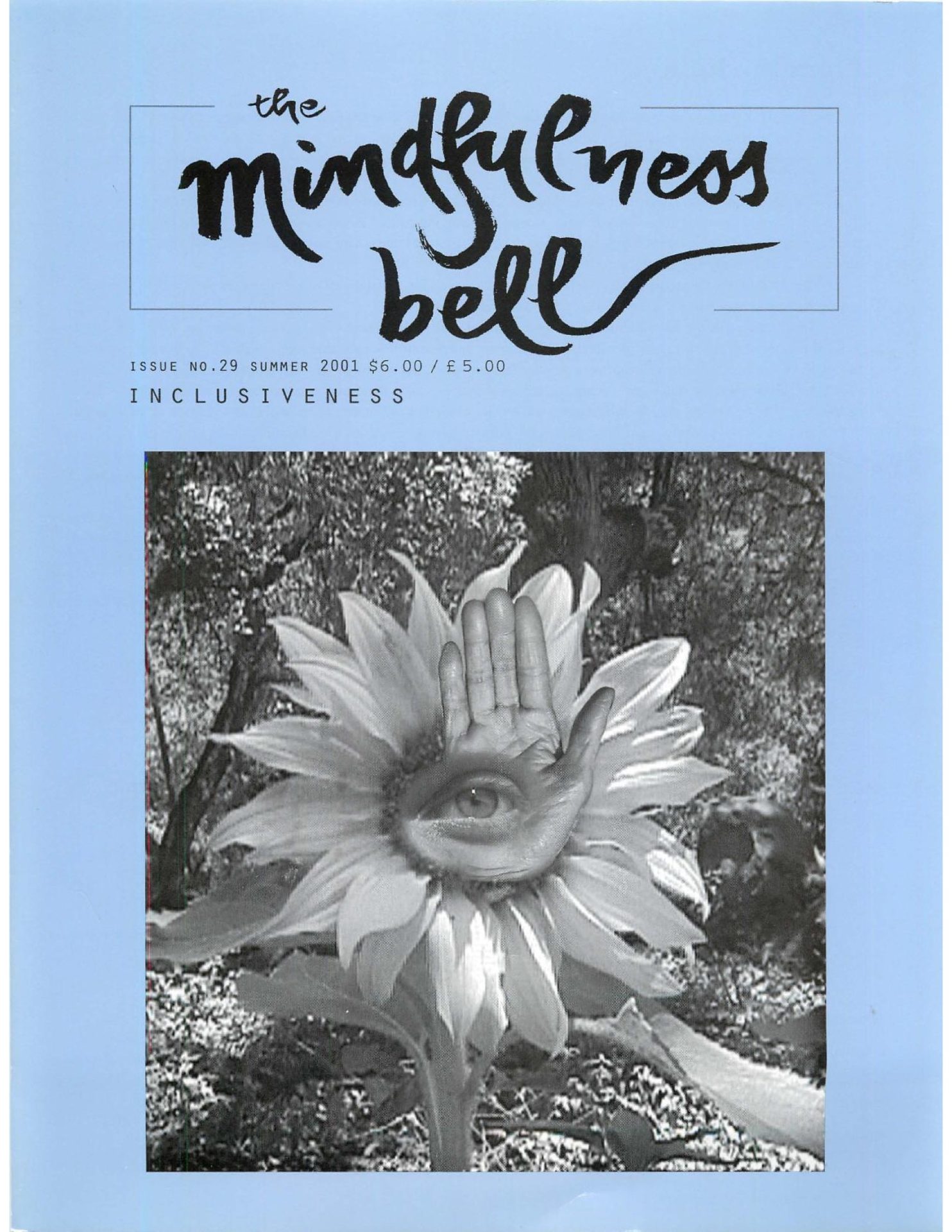By Kathleen Braza
On December 8, 2000 thirty-four individuals began a life transforming pilgrimage to ancient Buddhist sites in India and Nepal. The trip was organized by Jerry and Kathleen Braza and led by Shantum Seth.
The pilgrims included people from Oregon, Massachusetts, Arizona and Norway. This particular Sangha, however was unique in that it also included young college students from Western Oregon University, ages 19-25 , many of whom had never left their home state.
By Kathleen Braza
On December 8, 2000 thirty-four individuals began a life transforming pilgrimage to ancient Buddhist sites in India and Nepal. The trip was organized by Jerry and Kathleen Braza and led by Shantum Seth.
The pilgrims included people from Oregon, Massachusetts, Arizona and Norway. This particular Sangha, however was unique in that it also included young college students from Western Oregon University, ages 19-25 , many of whom had never left their home state.

Our journey began in New Delhi where Shantum blessed us with a visit to his own home where we met his family, including his beautiful wife, Gitu. After a moving visit to the Gandhi Memorial in New Delhi and a side trip to Agra to meditate at the site of the magnificent Taj Mahal, we began our journey by bus and plane, through India and Nepal.
Like Siddhartha in the early years, most pilgrims quickly became aware of the fact that they had indeed been sheltered from the suffering of life and the challenge became one of breaking through our "comfort zones" and opening to the sights, sounds, smell s, tastes and experiences that were India. Even greater challenges awaited us as we daily faced the countless, nameless beggars of all ages, many with unimaginable maladies. How does one begin to respond with an open heart? When do you give and how can you not give? David , one of our students, shared an excerpt from his journal. . . " We shared lunch in the Bamboo Grove today - a place where Buddha used to teach, meditate, and bathe. After lunch, on our way to the bus, I saw an old beggar woman sitting on the ground with a small bowl in front of her. Our eyes connected fo r a moment. Her hands reached out to me and her fingers pulled toward her mouth. I pulled my eyes away and looked to the ground. We had seen so many beggars on the trip. Yet later, I don't think I have ever felt such a sense of shame more deeply in my life . It is not often I worry what others think of me, but I later wondered what that woman thought of me as I walked away fro m her. At that moment, I let myself feel something I had tried to hide from most of my trip ." After a time, most pilgrims learned that looking at someone with the eyes of compassion, bowing gently with "Namaste," and giving when moved to do so, was a place to begin.
One of the blessings of the trip was our visits to several medical clinics which gave us a marvelous opportunity to see the healing effects of many individuals in providing health care for so many. One clinic specialized in providing quality eye care for the poor. Another offered rehabilitatio n to children with polio. It was at these clinics that we interacted with patients , learned from their caregivers, and were able to make donations that we knew would be used for continued care of more people.
Our journey took us to the main sites where Buddha was born, where he taught, walked, meditated, was enlightened and died. We also had the privilege of visiting a school in Bodh Gaya for " untouchable" children. We came armed with books, school supplies, inflatable globes and donations, all of which were received with deep gratitude and love. The children danced and sang for us, their words transcending language barriers. Our hearts were full.
We sang and chanted, ate curried dahl and many other Indian dishes, walked mindfully, and shared our life stories as we traveled long and bumpy roads throughout the countryside of India and Nepal. We marveled at the simplicity of life we observed and the smiles and open-hearted warmth of the many people we connected with, however brief our meeting. We located candles from our boat on the Ganges in memory of loved ones and sang Hindu chants during our endless wait at the Nepal border. We moved as one from place to place, always aware of our "second body," a system Shantum set up at the beginning of the journey to watch over each other. And every evening, we came together to share. We gathered to debrief, to support, to encourage, and to savor the safety and trust that built as each day unfolded and ended.

We shopped too, and not only came home with indelible memories, but singing bowls and bell s, silk from our visit to the silk factory in Varanasi, Buddhist tonkas, malas, Buddha statues and end less rolls of film to be developed and later shared at numerous post-trip gatherings. Ken, a guitar player and our only Indian student, began the trip searching for a "sitar" and finally found it in Kathmandu on the last day of our trip. Ken writes, "I am enjoying my sitar a lot. It seems my mom is playing it more that me. Her father used to play when she was little, so when she plays the sitar, she reflects back when her father was alive. Her father wanted her to learn how to play the sitar, but she didn't want to learn an "old world instrument" back then. Now she is teaching me to play." Ken went on the journey, yet his mother's life was also forever changed.
To this day, the Oregon pilgrims continue to meet in large and small groups to share their thoughts and feelings. The pilgrims from other places have found deeper connections with their Sanghas back home. Many express the feeling of still "walking in India" and are actively involved in fundraising efforts for the school in Bodh Gaya and for oral surgery for a severely deformed beggar child, Munni , "adopted" by the heart of the group. Munni was just one of many beggar children who gathered around our bus whenever we stopped. However, this seven-year-old-child bad her hand over her mouth and when she briefly removed it, the pilgrims on that side of the bus were horrified and deeply moved at the severe oral disfigurement that made it not only impossible for her to smile, but we later discovered that just eating was a monumental task. Several pilgrims decided to find where this child lived and see ifher fam ily could be connected to the various clinics we visited. The teacher at the school we visited helped us make the connection and Munni may soon be getting an opportunity for high-tech medical care and may smile for the first time in her short life. As Shantum expressed, "It may seem like just drops in the ocean, but we all know the ocean is made of many drops."
The spirit of this pilgrimage lives in each individual in unique and healing ways. As time moves on, it is easy to slip into old habit energies, but the expanded awareness and memories of India are forever etched somewhere in our hearts and minds and we can never be the same again.
Kathleen Braza and her husband, Jerry, True Great Response, live in Salem, Oregon and practice with the River Sangha.
Meditate ... Educate
Out of this pilgrimage to India a fundraising effort was developed, called "Meditate . . . Educate - Change the life of an Indian child forever! Give the gift of Education." The group is offering meditation cushions, covers made in Bodh Gaya and filled with buckwheat hulls. The sale of the cushions will go towards educating children at the Pragya Vihar School serving 350 chi ldren aged 5-12. These ch ildren are selected from the poorest fam ili es in which both parents do not have literacy skills. The cost of educating one child per year is around $40. Contact Jerry Braza, Great True Response, at 503-391-1284 or jbraza3629@aol.com for more details and to contribute to this project.

